Barangaroo
The woman behind the name
Barangaroo is located on the north-western edge of Sydney CBD, originally inhabited by the Gadigal people who hunted and fished there. The name is in honour of Barangaroo, the Cammeraygal woman of considerable influence in the early days of British colonisation. She was the second wife of Bennelong, a Wangul man, who was her second husband. Her first husband died of smallpox. She had three children, none of whom lived very long. Her power came from her role as a hunter and provider, providing fish for the clan using a simple black wood canoe known as a Nawi. She only caught as much fish as was required for the clan’s needs. She was described as striking, a little frightening, with firm beliefs and not easily swayed. She was thought to be around 40 and was very knowledgeable of the laws, teaching and women’s rituals. She refused to wear European clothes or drink the British wine and ‘dressed up’ for British events by painting herself with white clay and with a bone through her nose.
Bennelong, her second husband, was the ‘the interlocutor’ between the Aboriginal people and the British and she did not agree with him performing this role. On one occasion, she refused to visit the Governor with Bennelong. Despite her opposition, he went anyway, returning to a broken fishing spear as the evidence of her rage.
They were both determined and short tempered; when he hit her - often - she hit back.
She died in 1791, shortly after giving birth to her and Bennelong’s child, although the cause of death isn’t recorded. She was cremated with her fishing gear and her ashes spread in Governor Phillip’s garden. Bennelong died in 1813 and was buried on the banks of the Parramatta River in an orchard owned by James Squire, a friend and the first Australian brewer of note. His grave is in Putney, between a family’s front lawn and a council owned nature strip.
The area, previously known as Millers Point and East Darling Harbour, was renamed Barangaroo in October 2007. There were 1600 entries in a State-wide competition held in 2006.
A cropped image from the painting with Bennelong (l) and Barangaroo (r) about to meet the Governor. From the Natural History Museum London
The area
In the 1820s windmills were built on Millers Point and colonists started to move to the area, building houses and creating a village. In the 1830s the first wharf was constructed, in 1843 The Australian Gas Light Company built and operated a gas works in East Darling Harbour. This industry brought more residential and dockland development and more commercial shipping. A direct route from The Rocks to Millers Point, The Argyle Cut was created in 1859, a safer and quicker route and a major catalyst for development in this area.
The area includes The Hungry Mile, the name harbourside workers gave to the dockhands area during the Great Depression where workers would line up on the mile long stretch of wharfs, in search of a job, often with no success. The section of Barangaroo, Hickson Rd between the Munn Street overbridge and the Napoleon St intersection was officially designated the Hungry Mile in 2009.
From the 1860s to 1950s the area grew significantly, the waterfront covered in warehouses and storage facilities. The demise of the commercial shipping in the area was due to automation via containers and poor access for large trucks to the area and the development and expansion of Port Botany, Port Kembla and Newcastle port facilities. Barangaroo South was turned into a massive concrete apron in the 1950s, followed by Barangaroo North in the 1970s.
In 2003 the NSW Government decided the area would be developed into commercial office space and recreational areas rather than shipping and stevedoring facilities. Design and planning took place from 2005 – 2012, with an international design contest in 2005 attracting 139 submissions, being won by Hill Thallis Architecture + Urban Projects Paul Berkemeier Architects and Jane Irwin Landscape Architecture in March 2006. Further planning and viability assessment resulted in the Hill Thallis design being dismissed and a consortium made up of Lord Rogers and Lendlease won out.
Prior to redevelopment the site hosted events for World Youth Day 2008 and was a cruise ship passenger terminal.
Wharves on Hickson Rd
The development
Barangaroo South is the extension of Sydney’s CBD with office buildings, apartments restaurants and retail. I watched the three International Towers being built from Westpac’s tower in Kent St. The lift wells of the nearest one hold more than the floor numbers, which will never be seen publicly. The concrete walls of the lift wells are marked with the events that occurred when they built each floor. Christmas, Easter, the sad demise of cricketer Phil Hughes, and, of course, a picture of a topping pine tree, the ritual when all buildings are finished. Barangaroo Central includes the Crown building with the hotel and restaurants opened in December 2020 and will contain low rise residential and more commercial buildings.
Barangaroo Reserve is a six-hectare recreated headland park, based on the pre-1836 shoreline (which had been cut away to make way for the wharves and stevedoring activities). The parkland features grassed areas, lookouts, walking and cycle paths, a cultural facility called ‘the Cutaway’, two new harbour coves and tidal rock pools created from the 10,000 Hawkesbury sandstone blocks excavated from the site. It was designed by internationally acclaimed American landscape architecture firm PWP Landscape Architecture, under the leadership of Peter Walker, famous for the World Trade Centre National September 11 Memorial and Museum in New York. It was built by Lendlease Engineering.
Our day
After a kick start coffee, we headed from Barangaroo South to the Munn St Reserve, part of the land granted to James Munn who operated a shipbuilding yard and floating dry dock. On the way we passed a croupier training session being held in one of the buildings on Hickson Rd (I think they shut the door after we walked past). They must have been getting ready for a casino opening! We could have volunteered to be their practice gamblers, but we had a full day ahead.
Aboriginal Cultural Tour
Our Aboriginal Cultural Tour started near the Munn St Reserve entrance. We were greeted by Tim, resplendent in a waterproof jacket complete with rain drops. It rained, it poured, we were too interested to listen to what Tim said to notice if the old man snored. Tim opened our eyes and ears to the spiritual and cultural history of this area and the value of the land to the Gadigal people who lived here.
Barangaroo’s Botany
75,000 native trees, plants and shrubs have been used to landscape Barangaroo Reserve, with 84 species chosen. Many from seeds and cuttings were collected from wild sites around Sydney Harbour and the Hawkesbury River. Only five species are not native to Sydney Headlands and were included for symbolic reasons as iconic plants of the Sydney basin - four of them are the Spotted gum, Gymea Lily, Sydney Blue Gum and Water Gum. The fifth was a bottle brush, Callistemon citrinus, “Anzac” - an appropriate gesture given Barangaroo Reserve opened during the centenary of Gallipoli.
Because the Barangaroo Delivery Authority wanted Barangaroo Reserve to open in 2015 with maximum visual impact, 16 mature fig trees from southern Queensland and 89 cabbage tree palms were transplanted into the park. The remaining trees, bushes and plants were grown under special conditions at the Andreasens Green wholesale nursery at Mangrove Mountain on the Central Coast. It was chosen partly because the landscape and climate are similar to that of Barangaroo Reserve. The plants were grown under specialist conditions - including a custom-made potting mix devised by soil scientist Simon Leake.
Before each tree left Mangrove Mountain for Barangaroo, 31 plant quality control items had to be satisfied. The attention proved invaluable. Typically between 10-15% of plants are usually lost on a project this big, yet only 1% failed at Barangaroo Reserve. This was also enhanced by the reconstructed soil profile, made up of 80% recycled materials - crushed sandstone and sand from the excavation and recycled green garden waste compost and composted wood mulch.
Planting at Barangaroo Reserve started in February 2014. The final tree - a Forest Red Gum (Eucalyptus tereticornis) - was planted on Walumil Lawns on 28 July 2015, before the Reserve opened to the public on 22 August. Since 2015, more than 60 extra mature trees have been added on Stargazer Lawn to provide additional shade and protection, including Morton Bay Figs, Grey Gums, Red Gums and Scribbly Gums.
Munn’s boatyard at Nawi Cove
Down to Nawi Cove, where archaeological excavations at the beginning of the Barangaroo Reserve project found the remains of a slipway from James Munn’s (of Munn St & Munn Reserve fame!) 1820s boatyard on the site. It comprised an area of flat sandstone blocks forming the ramp of the slipway, with semi-dressed stones along either edge with a decayed timber rail running down the centre of the slipway. The remains of the Slipway were reburied for protection whilst the construction was being undertaken.
Tims’ tools
2022 Biennale: Rivus
We said goodbye to Tim and took advantage of 2022 Biennale: Rivus being held at the same time as our walk. The first exhibit was Leaf Work by John Gerrard – a huge screen on Stargazer Lawn with a walking man covered in…..leaves. He ‘seems to be consigned to walk for eternity’. John uses the same technology employed by video game designers.
The second exhibit was The Great Animal Orchestra, ‘a singular and memorable encounter with our living planet’. Bernie Krause and other Visual Artists have created a soundscape of 15000 animal species from 7 different locations.
The third exhibit, held in the Cutaway, exhibited several artists, some of their works appear below.
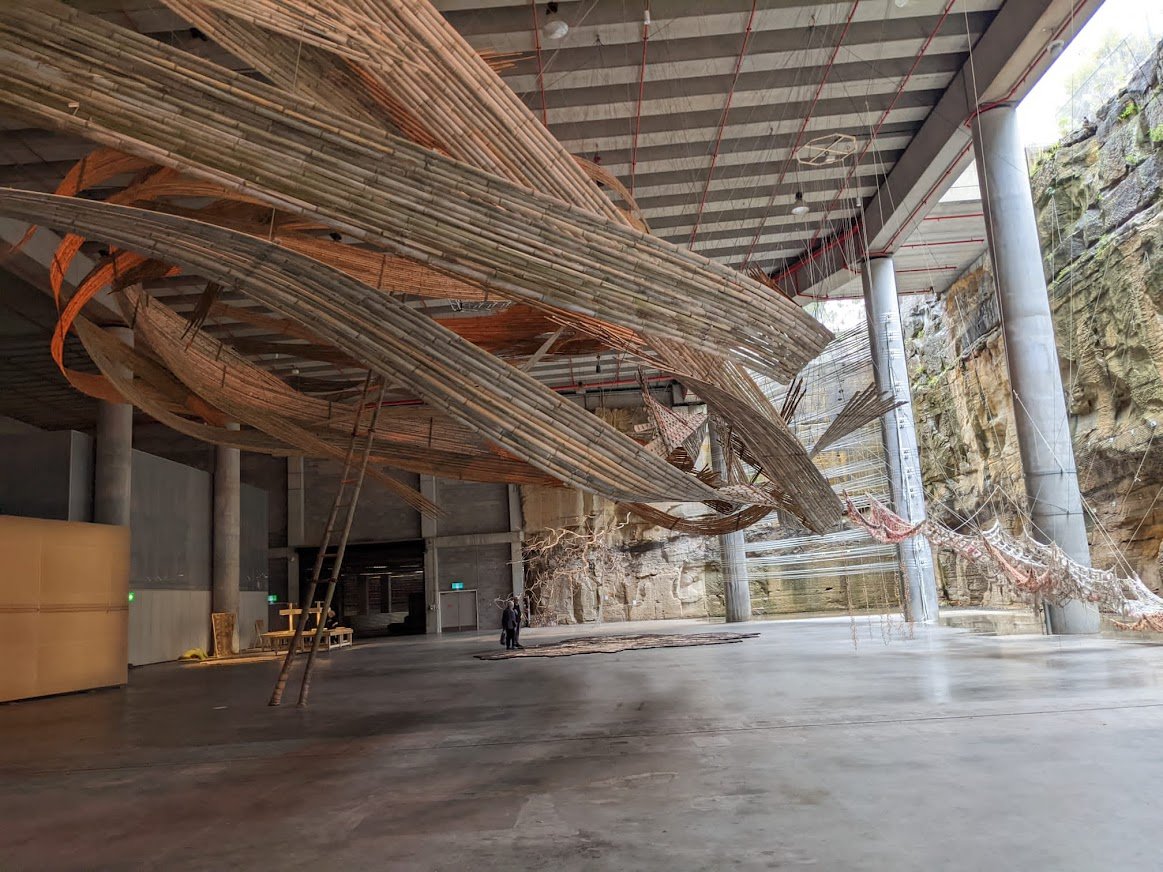
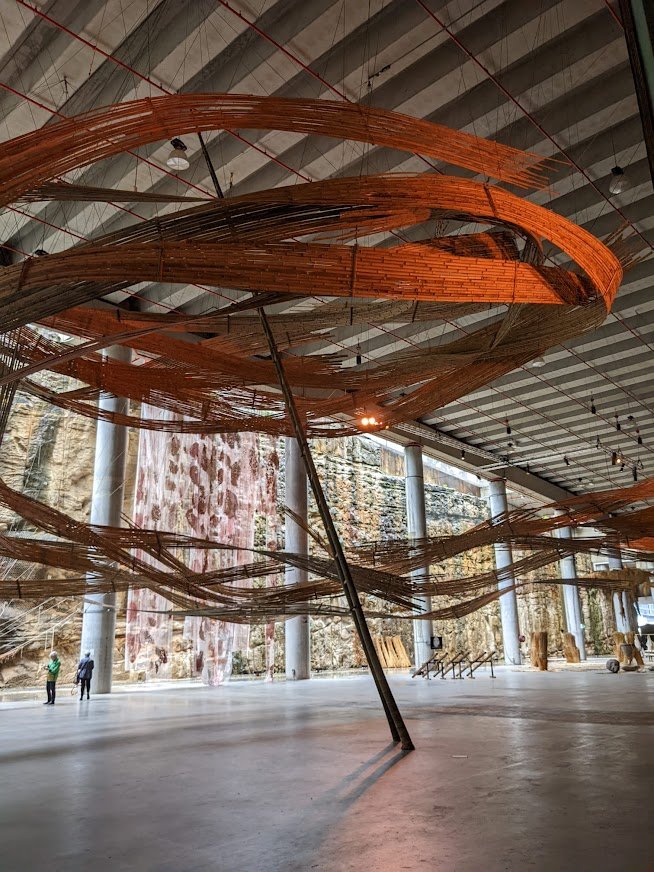




The Cutaway
The Cutaway is a flexible shell space, 6500 m2 and 14 metres tall. The dramatic sandstone cliff face was formed by convicts, hence the original name of ‘cutting away’ the rock. Most of the sandstone that created the headland of Barangaroo came from the area below The Cutaway, the car park. Some interesting facts:
The design of the sandstone foreshore follows the natural Sydney fault line (roughly 20 degrees northwest), so the new headland is in line with natural Sydney Harbour headlands.
93% of the sandstone used at Barangaroo Reserve was sourced from the on-site extraction pit. The remainder was acquired from Bundanoon Quarries, Capricorn Quarries and Gosford Quarries.
The sandstone was extracted from the headland using traditional stonemason techniques coupled with pioneering Australian-designed multi-bladed saws.
Three grades of sandstone block were identified in the extraction pit: dry, wet and tidal. The strongest stones are those which are exposed at low tide and submerged at high tide.
Every grain of sandstone extracted from Barangaroo Reserve was used. Offcuts were ground up and mixed to become the sandy topsoil required by the 75,000 trees, plants and shrubs of the headland.
The extraction process took a year - from December 2012 to December 2013.
Almost 300 different sizes of sandstone blocks have been used in the construction of the foreshore.
Each block was given a “barcode” (either a plastic tag or spray-painted number) to identify where it should go in the foreshore.
A custom-made 12D computer modelling program was created enabling each part of the foreshore to be mapped out precisely in advance, meaning every individual block could be slotted perfectly into place like a giant 3D jigsaw.
A custom-made piece of equipment, known as “the block handler” or “the grab”, was designed to allow the perfect placement of each block with no gap between neighbouring blocks.
A mobile phone app was developed to keep track of exactly how many blocks of different sizes were on site at any one time.
Not a single worker suffered any serious injury during the construction of Barangaroo Reserve.
Lunch
Off on the Wulugul Walk back to Barangaroo South for lunch. Wulugul is the Aboriginal word for kingfish, common to Sydney Harbour. Lunch was at The Butcher’s Block, in Tower One. We’d chosen a bowl or burger and beer/wine soft drink option, I highly recommend the Kingfish sashimi bowl and the beef burger with sweet potato chips (shared – bit naughty, bit healthy) and everyone else recommended whatever they ate! Everyone dived in and forgot photos.
The Crown Sydney
Off to our final location, the Crown Sydney wealth bubble. We entered through the doors on Hickson Road, passing a sculpture and two merlions to notice the reception desk, representing the water shoreline, and designed, like that shoreline, to erode. The vase installation and suspended glass artwork are stunning. We were greeted firstly by the Crown signature scent, a blend of lemon, lavender, oakmoss, tonka bean and sandalwood. ‘The sensory experience creates an iconic smell that we can take with us, or when we return it brings back memories’. Second greeting was by the very pleasant Ben Hughes, VIP Service Manager, our tour guide extraordinaire.

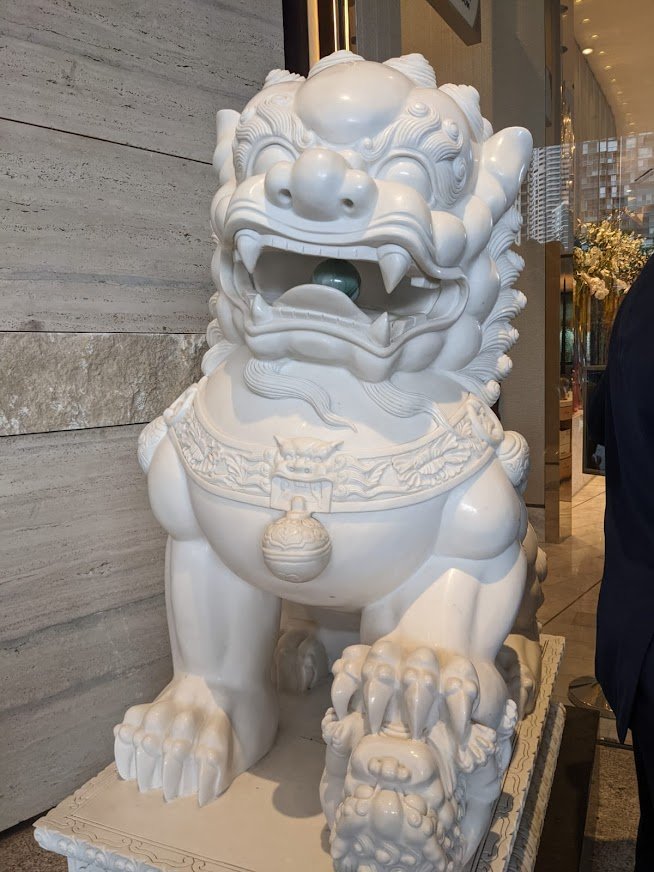


He starts by telling us the scent is made by Prada and then speaks about the retail outlets, Paspaley pearls (the most rare and valuable pearls in the world) and Watches of Switzerland, offering ‘the latest timepieces from a specially curated selection of premiere luxury watch brands’. They will source unique and second-hand watches on behalf of their customers from all over the world. The third retail outlet remains empty as the customer demographic has changed since the hotel has opened (thank you covid and not being able to use their gaming licence – yet) and they are yet to settle on the right outlet for the clientele. Ben hoped for an outlet that sells Crown stuff – the pillows, beds, duvets, towels, that amazing scent….. but doesn’t think that’ll happen.
The 88-storey tower was designed by Chris Wilkinson, architect of the London based practice of Wilkinson Eyre, winner of the design competition Crown Resorts launched in 2012. A five-metre-tall rendition of the sculpture that formed Chris’ original ideas, carved from the same Carrara marble as the filigree that wraps the podium, is here. Most of the interiors were designed and Chris’ vision realised by the design studio of Meyer Davis of New York. The studio designed all the public spaces, some of the restaurants and bars, the ballroom, meeting spaces, all 349 rooms, suites and villas, the amenity spaces and the 82 luxury residences serviced by the hotel – although new owners add their own customised designs.
Some of the original/ modified/ rejected designs adorn the columns outside the Hickson Rd entrance.




Due to the curving glass façade, the hotel has 8100 individually sized pieces of flat glass, cut to look curved. There are 51 types of marble. Each room is slightly different, and each floor is different. Room prices range from $980 - $48,800 per night. Residences start from $9 million for a 1-bedroom, median price of the apartments is $22 million.
There is marble, stone, wood and metal everywhere – and then there is the staircase. Starting on the first floor it curls up to the fifth floor, light filtering to all levels, topped with a skylight showing the amazing building above. The interior of the stairwell is bound by 396 light rods clad in crystal created by Preciosa, a 473-year-old Czech Republic glass maker business. An abseiler cleans the crystals, hooked into the ceiling of the sixth floor. Abseilers also clean the external windows. There are days when windows can’t be cleaned due to wind or rain, resulting in around 50 – 70 rooms often not being available.

The stunning crystals surrounding the staircase

More staircase

And more staircase

The view from the ceiling above the staircase 1

The view from the ceiling of the staircase 2

An abseiling hook!
There are two floors holding swimming pools, we got to see the fifth-floor hotel guests’ pool, the residents’ pool is on the sixth floor.


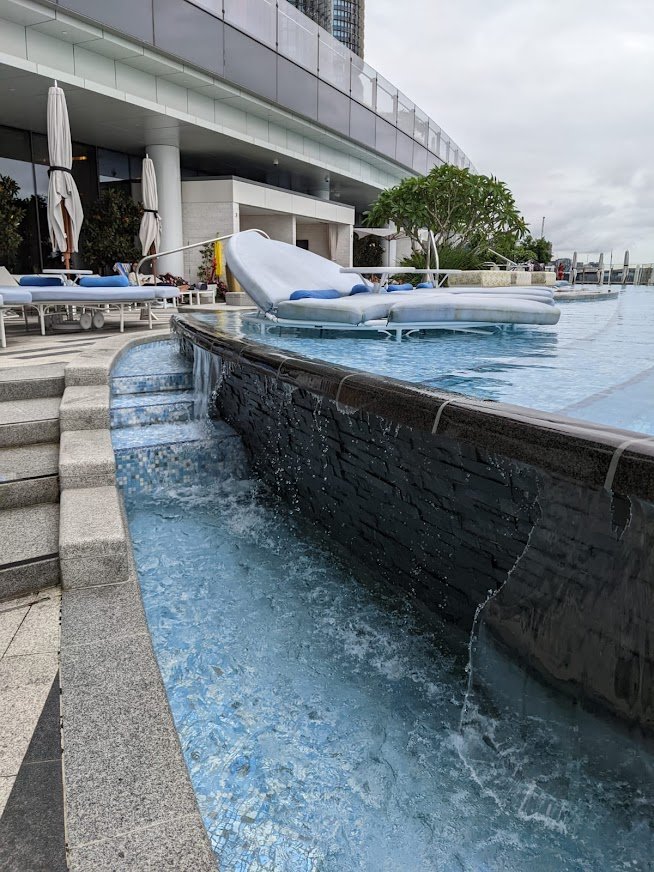

The Crown has an application process for its probably/ potentially/ possibly forthcoming Casino. The Casino will hold 3,500 people, members only with potential members requiring proven Gold tier status from other casinos – seasoned gamblers with serious money. When they can use their licence they will be ready for the onslaught of requests. When the venue first opened they had 17,000 bookings in the first 48 hours.
The Crown has a Responsible Gaming Approach, Committee and, visibly, a Centre, providing onsite support for customers seeking assistance with their gaming behaviours. Of course, its currently not in use.
Off to the restaurants! We started with The Waiting Room, TWR, the lobby bar with that wonderful western view, offering drinks, snacks and meals, extending to high tea. The furnishings are such that privacy is a given, and the outside area is the same size as inside.
A’Mare, the fine dining Italian restaurant, is operated by Alessandro Pavoni of Ormeggio, The Spit and Chiosco fame. Pasta with pesto is made at the table; when we dined, the smell of the basil at the table next to us was sooo fresh.
Woodcut restaurant holds 276 people, and uses traditional methods of ‘fire, steam, smoke and ice’ to prepare the food. The couple behind the restaurant, Ross and Sunny Lusted ran The Bridge Room for many years and then took off overseas to experience more and bring that experience to Woodcut, with its four open kitchens displaying its wood oven, charcoal grill, wood burning grill and kettle steamers.
Up the lift, turn right and a door to the left leads to Yoshi’s Omakase ‘the ultimate in culinary zen’. Originally the restaurant held 12 guests, now reduced to 10 to ensure comfort. Yoshi is renowned as an Omakase (where the dishes are selected by the chef – ‘I’ll leave it to you’) sushi master.
Yoshi sees the rice as the main player, its ‘cooked under pressure in a clay pot over charcoal. The grains are then seasoned with sake-lees vinegar and kept in a basket to Yoshi’s right. He shapes a handful of rice, deftly inviting the grains to cling together with a clap and flourish’.
I think the seafood comes a close second.
Just past Yoshi’s is Nobu, the Japanese restaurant whose owner, Chef Nobu Matsuhisa, rose to fame when Robert De Niro ate at his Los Angeles restaurant, Matsushia, in 1988 and the next year suggested they open a restaurant in New York. It took another five years for that to happen. There are now over 50 Nobu restaurants and 13 hotels. The signature dish is black cod with miso, a De Niro favourite.
The Teahouse is next, although I think more cocktails may be drunk here than tea. The opulent room, oozing with rich velvet and gold has tables and ‘birdcages’, available for up to 12 people with a minimum spend.




Epicurean is the breakfast, lunch, dinner buffet option at Crown. Semi-private areas can be booked. The wine cellar is extraordinary – top price for a bottle is $70,000. There are three sommeliers who travel the world looking for rare wines.
The chocolate fountain is every child’s dream and probably most adults. Its the biggest in the southern hemisphere.
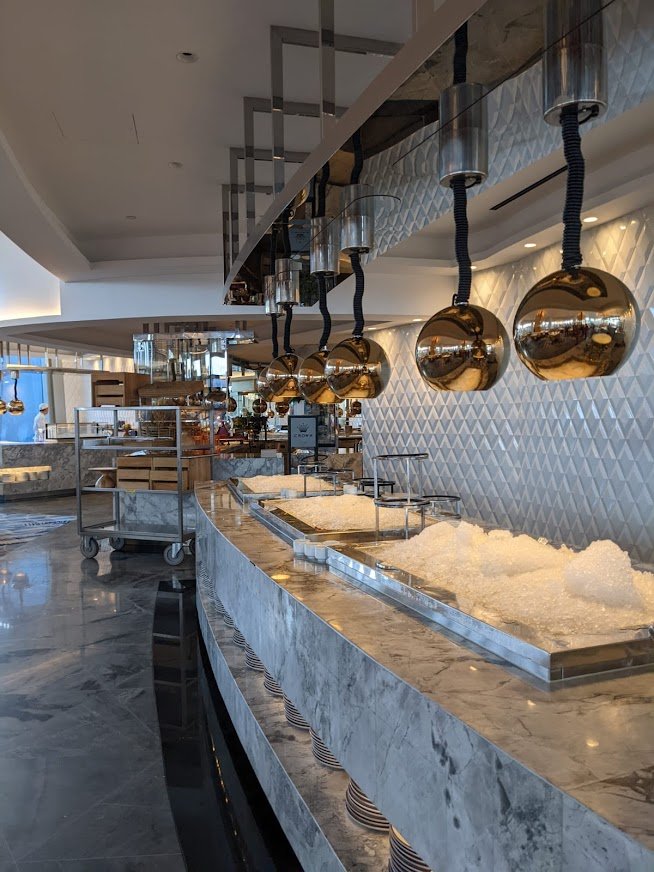

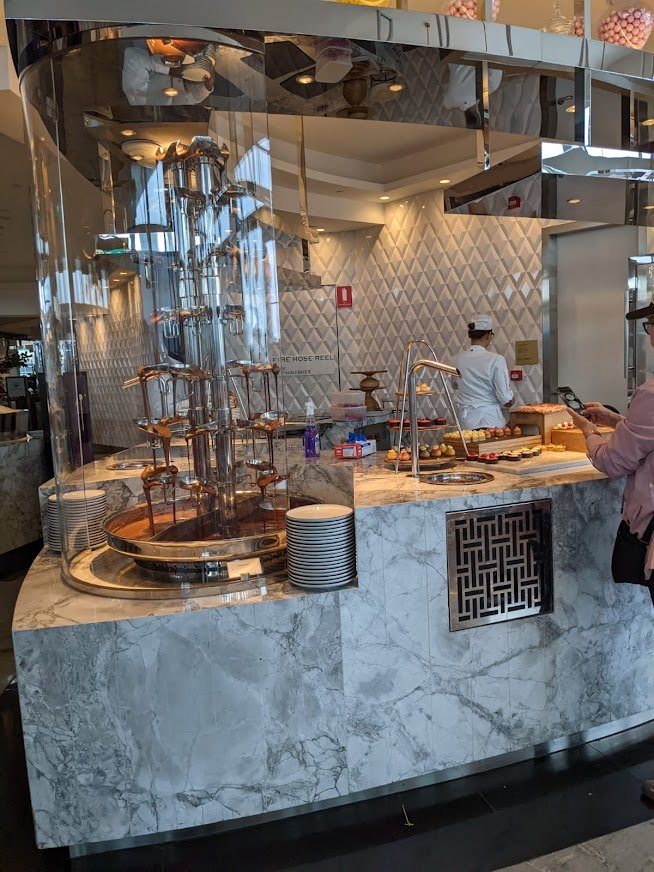
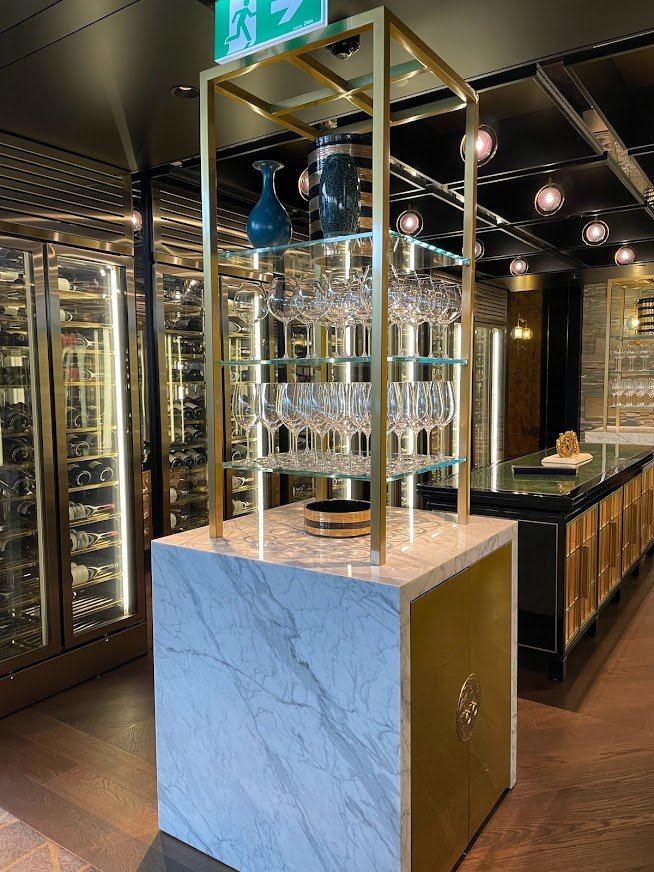


Finally, to Oncore by Clare Smyth, the first and only British female chef to hold three Michelin stars in the UK, and one of seven in the world. The menu features some of her classic Core dishes, including her signature dish Potato and Roe and new dishes with a unique Sydney flavour.
In Ben’s opinion, if you can only eat once at Crown and money is not a concern, eat at Oncore. All the best with getting that booking, opening at 09:00am the first of the month for the following month.
We say goodbye and thank you to Ben for an informative, eye-opening experience.
That’s it! There is artwork around Barangaroo South – saved for another day. Ferry ride home, another bath, another cup of tea.
References
https://www.barangaroo.com/about/the-place/history/barangaroo-the-woman
https://dictionaryofsydney.org/entry/barangaroo_and_the_eora_fisherwomen
https://en.wikipedia.org/wiki/The_Hungry_Mile
https://en.wikipedia.org/wiki/Topping_out
Barangaroo » Sandstone spectacular
https://www.barangaroo.com/whats-on/tours/aboriginal-cultural-tours
What are native bees? (aussiebee.com.au)
Barangaroo » Barangaroo Botany
https://icsconservation.com.au/project/munns-slipway/
Barangaroo » Sandstone spectacular
Brand Fragrancing - World Environmental Technologies (worldenvirotech.com.au)
Australian Pearls Online - Explore The Range At Paspaley
Rolex Official Retailer Luxury Store Sydney | Watches of Switzerland (watchswiss.com)
Behind the design of Sydney’s Crown Tower (afr.com)
Design highlights of Sydney's Crown Tower (afr.com)
How Robert De Niro Convinced Nobu to Build a Restaurant Empire - Eater
























